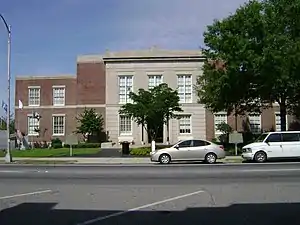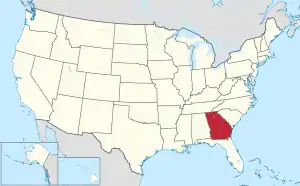Coffee County | |
|---|---|
 Coffee County Courthouse in Douglas | |
 Location within the U.S. state of Georgia | |
 Georgia's location within the U.S. | |
| Coordinates: 31°33′N 82°51′W / 31.55°N 82.85°W | |
| Country | |
| State | |
| Founded | February 9, 1854 |
| Named for | John E. Coffee |
| Seat | Douglas |
| Largest city | Douglas |
| Area | |
| • Total | 603 sq mi (1,560 km2) |
| • Land | 575 sq mi (1,490 km2) |
| • Water | 28 sq mi (70 km2) 4.6% |
| Population (2020) | |
| • Total | 43,092 |
| • Density | 74/sq mi (29/km2) |
| Time zone | UTC−5 (Eastern) |
| • Summer (DST) | UTC−4 (EDT) |
| Congressional district | 12th |
| Website | coffeecountygov |
Coffee County is a county located in the southeastern part of the U.S. state of Georgia. As of the 2020 census, the population was 43,092,[1] up from 42,356 at the 2010 census.[2] The county seat is Douglas.[3]
Coffee County comprises the Douglas, Georgia micropolitan statistical area.
History
Coffee County was created by an act of the Georgia General Assembly on February 9, 1854, from portions of Clinch, Irwin, Telfair, and Ware counties. These lands were originally ceded by the Creek in the Treaty of Fort Jackson in (1814) and the Treaty of the Creek Agency (1818) and apportioned to the above counties before becoming Coffee County.
Berrien (1856), Jeff Davis (1905), and Atkinson (1917) counties were subsequently formed from sections of Coffee County.
The county is named for General John E. Coffee, a state legislator and a U.S. representative.[4][5]
Coffee County Correctional Facility is located in Nicholls, Georgia. It is privately owned and operated by CoreCivic, the largest prison company in the nation.
Many of the early settlers of what is now Coffee County are buried in historic cemeteries across the region, including the cemetery at Lone Hill United Methodist Church—located at 6833 Broxton-West Green Highway, some 10 miles northeast of Douglas. The church and its cemetery date to the 1840s, with the earliest marked grave dated 1848. A majestic Eastern Redcedar has graced the cemetery for generations and is recognized as the nation's largest of this species through American Forests’ Champion Trees program. (see:[6]) In July 2018 the tree was recognized as 2018's Great American Tree by American Grove. (See:[7]) Having been nominated by Mark McClellan of the Georgia Forestry Commission, the tree has been featured in such publications as the Smithsonian Magazine and Janisse Ray's Wild Card Quilt. The circumference of the tree exceeds 20 feet.
Geography
According to the U.S. Census Bureau, the county has a total area of 603 square miles (1,560 km2), of which 575 square miles (1,490 km2) is land and 28 square miles (73 km2) (4.6%) is water.[8]
The vast majority of Coffee County is located in the Satilla River sub-basin of the St. Marys-Satilla River basin. The northern corner of the county, well north of Broxton, an area bisected by State Route 107, is located in the Lower Ocmulgee River sub-basin of the Altamaha River basin. The very southwestern corner of Coffee County, northeast of Alapaha, is located in the Alapaha River sub-basin of the Suwannee River basin.[9]
Highways
Adjacent counties
- Telfair County – north
- Jeff Davis County – northeast
- Bacon County – east
- Ware County – southeast
- Atkinson County – south
- Berrien County – southwest
- Irwin County – west
- Ben Hill County – west
Communities
Cities
Unincorporated communities
Demographics
| Census | Pop. | Note | %± |
|---|---|---|---|
| 1860 | 2,879 | — | |
| 1870 | 3,192 | 10.9% | |
| 1880 | 5,070 | 58.8% | |
| 1890 | 10,483 | 106.8% | |
| 1900 | 16,169 | 54.2% | |
| 1910 | 21,953 | 35.8% | |
| 1920 | 18,653 | −15.0% | |
| 1930 | 19,739 | 5.8% | |
| 1940 | 21,541 | 9.1% | |
| 1950 | 23,961 | 11.2% | |
| 1960 | 21,953 | −8.4% | |
| 1970 | 22,828 | 4.0% | |
| 1980 | 26,894 | 17.8% | |
| 1990 | 29,592 | 10.0% | |
| 2000 | 37,413 | 26.4% | |
| 2010 | 42,356 | 13.2% | |
| 2020 | 43,092 | 1.7% | |
| U.S. Decennial Census[10] 1790-1880[11]1890-1910[12] 1920-1930[13] 1930-1940[14] 1940-1950[15] 1960-1980[16] 1980-2000[17] 2010[2] 2020[1] | |||
| Race | Num. | Perc. |
|---|---|---|
| White | 24,158 | 56.06% |
| Black or African American | 11,872 | 27.55% |
| Native American | 62 | 0.14% |
| Asian | 299 | 0.69% |
| Pacific Islander | 14 | 0.03% |
| Other/Mixed | 1,257 | 2.92% |
| Hispanic or Latino | 5,430 | 12.6% |
As of the 2020 United States census, there were 43,092 people, 14,438 households, and 9,913 families residing in the county.
Education
Douglas is home to South Georgia State College, the oldest two-year institution under the University System of Georgia.
Politics
Like most of the Solid South, Coffee County voted with the Democrats until 1964, when Republican Barry Goldwater carried the county as well as the state. Democrat Jimmy Carter, who came from Georgia, carried the county twice. No Democrat has carried the county since then. Bill Clinton was the last Democrat to get over forty percent of the county's vote, in the 1996 United States Presidential election in Georgia.
| Year | Republican | Democratic | Third party | |||
|---|---|---|---|---|---|---|
| No. | % | No. | % | No. | % | |
| 2020 | 10,578 | 69.53% | 4,511 | 29.65% | 125 | 0.82% |
| 2016 | 9,588 | 68.50% | 4,094 | 29.25% | 316 | 2.26% |
| 2012 | 9,248 | 63.89% | 5,057 | 34.94% | 169 | 1.17% |
| 2008 | 8,872 | 64.49% | 4,811 | 34.97% | 75 | 0.55% |
| 2004 | 8,306 | 67.35% | 3,979 | 32.26% | 48 | 0.39% |
| 2000 | 5,756 | 61.04% | 3,593 | 38.10% | 81 | 0.86% |
| 1996 | 3,934 | 48.72% | 3,407 | 42.19% | 734 | 9.09% |
| 1992 | 3,778 | 45.31% | 3,275 | 39.27% | 1,286 | 15.42% |
| 1988 | 4,019 | 58.91% | 2,777 | 40.71% | 26 | 0.38% |
| 1984 | 4,200 | 61.47% | 2,633 | 38.53% | 0 | 0.00% |
| 1980 | 2,499 | 37.74% | 4,038 | 60.99% | 84 | 1.27% |
| 1976 | 1,417 | 23.55% | 4,601 | 76.45% | 0 | 0.00% |
| 1972 | 3,934 | 86.63% | 607 | 13.37% | 0 | 0.00% |
| 1968 | 1,241 | 19.52% | 1,331 | 20.94% | 3,785 | 59.54% |
| 1964 | 4,392 | 61.76% | 2,719 | 38.24% | 0 | 0.00% |
| 1960 | 987 | 22.62% | 3,376 | 77.38% | 0 | 0.00% |
| 1956 | 574 | 15.21% | 3,199 | 84.79% | 0 | 0.00% |
| 1952 | 1,078 | 24.67% | 3,292 | 75.33% | 0 | 0.00% |
| 1948 | 309 | 7.46% | 3,168 | 76.45% | 667 | 16.10% |
| 1944 | 366 | 18.38% | 1,625 | 81.62% | 0 | 0.00% |
| 1940 | 128 | 7.56% | 1,561 | 92.15% | 5 | 0.30% |
| 1936 | 116 | 6.38% | 1,702 | 93.57% | 1 | 0.05% |
| 1932 | 29 | 1.70% | 1,652 | 97.06% | 21 | 1.23% |
| 1928 | 591 | 33.45% | 1,176 | 66.55% | 0 | 0.00% |
| 1924 | 62 | 9.54% | 510 | 78.46% | 78 | 12.00% |
| 1920 | 230 | 35.06% | 426 | 64.94% | 0 | 0.00% |
| 1916 | 120 | 5.36% | 2,091 | 93.35% | 29 | 1.29% |
| 1912 | 28 | 2.78% | 895 | 88.79% | 85 | 8.43% |
See also
References
- 1 2 "QuickFacts - Coffee County, Georgia". United States Census Bureau. Retrieved May 4, 2022.
- 1 2 "State & County QuickFacts". United States Census Bureau. Archived from the original on November 25, 2015. Retrieved June 20, 2014.
- ↑ "Find a County". National Association of Counties. Archived from the original on May 31, 2011. Retrieved June 7, 2011.
- ↑ Gannett, Henry (1905). The Origin of Certain Place Names in the United States. Govt. Print. Off. p. 86.
- ↑ Krakow, Kenneth K. (1975). Georgia Place-Names: Their History and Origins (PDF). Macon, GA: Winship Press. p. 47. ISBN 0-915430-00-2. Archived (PDF) from the original on July 10, 2003.
- ↑ "Big Trees". American Forests. Archived from the original on August 7, 2016. Retrieved April 16, 2019.
- ↑ "Announcing 2018's Great American Tree". American Grove. Archived from the original on July 6, 2018.
- ↑ "US Gazetteer files: 2010, 2000, and 1990". United States Census Bureau. February 12, 2011. Retrieved April 23, 2011.
- ↑ "Georgia Soil and Water Conservation Commission Interactive Mapping Experience". Georgia Soil and Water Conservation Commission. Archived from the original on October 3, 2018. Retrieved November 27, 2015.
- ↑ "Decennial Census of Population and Housing by Decades". US Census Bureau.
- ↑ "1880 Census Population by Counties 1790-1800" (PDF). US Census Bureau. 1880.
- ↑ "1910 Census of Population - Georgia" (PDF). US Census Bureau. 1910.
- ↑ "1930 Census of Population - Georgia" (PDF). US Census Bureau. 1930.
- ↑ "1940 Census of Population - Georgia" (PDF). US Census Bureau. 1940.
- ↑ "1950 Census of Population - Georgia -" (PDF). US Census Bureau. 1950.
- ↑ "1980 Census of Population - Number of Inhabitants - Georgia" (PDF). US Census Bureau. 1980.
- ↑ "2000 Census of Population - Population and Housing Unit Counts - Georgia" (PDF). US Census Bureau. 2000.
- ↑ "Explore Census Data". data.census.gov. Retrieved December 9, 2021.
- ↑ Leip, David. "Dave Leip's Atlas of U.S. Presidential Elections". uselectionatlas.org. Retrieved March 19, 2018.